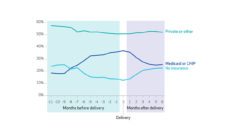Multiple pregnant women in Etowah County, Alabama have been arrested after testing positive for amphetamines. These women were charged with “chemical endangerment” of their fetuses—a relatively new interpretation of existing child abuse statutes. Those laws were originally meant to prevent exposure of children to drug-related environments such as methamphetamine laboratories, but the Alabama Supreme Court expanded the definition of child to include “fetuses,” meaning that pregnant women could be charged for using drugs (Kimbrough v. Alabama; Ankrom v. Alabama).
Alabama is not alone, as other jurisdictions have enacted measures to criminalize substance use during pregnancy. Recently, there has been a growing trend in pregnancy control measures in the United States and an increase in punitive policies toward women who use alcohol during pregnancy. These measures signal a growth in restrictions on sexual and reproductive health in general. According to the Guttmacher Institute, 30% of all such restrictions enacted since 1973 have only been established in the past six years. More than one-third of states punish pregnant women for substance use through pre-existing laws, erecting barriers to treatment. For example, in New Jersey, a pregnant woman using methadone prescribed to treat her opioid addiction—the accepted standard of care—faced a child abuse/neglect charge and her newborn subsequently was taken into custody (N.J. Division of Youth and Family Services v. Y.N.). In other states, by contrast, pregnant women who use substances have been civilly committed for declining similar addiction treatment. Currently, seventeen states hold that substance abuse during pregnancy qualifies as child abuse under civil child welfare statutes.
Punitive measures mistakenly pit the interdependent interests of the mother and fetus against each other.
Punitive measures mistakenly pit the interdependent interests of the mother and fetus against each other. To our knowledge, there is no credible medical evidence that punitive measures lower rates of substance abuse in pregnancy. Instead, punishment may drive women away from prenatal care and treatment for fear of arrest or loss of child custody. Even when rehabilitation is available as an alternative to prison, few treatment facilities provide adequate services to mothers. Only 17% of centers have programs specifically for pregnant and postpartum women.
These strict policies also turn physicians into agents of the state and undermine the crucial patient-physician relationship, a major foundation of therapeutic change. Eighteen states mandate reporting of suspected prenatal substance use and four mandate testing, despite concerns from numerous medical organizations. Alarmingly, physician reports are carried out in a discriminatory manner with low-income and minority women disproportionately affected. Although rates of substance use during pregnancy are similar across racial and socioeconomic groups, women of color are more likely to be reported to child protective services, even when drug screening policies are in place to universally test all women.
There is no evidence that punitive measures improve maternal or fetal outcomes.
There is no evidence that punitive measures improve maternal or fetal outcomes. More effective interventions would address the complex factors that contribute to substance use during pregnancy. Carrots, rather than sticks, should be used. One option is the expansion of contingency treatment programs, which offer rewards for abstinence and promote long-term abstinence and retention in treatment. Other approaches also hold promise, including investment in family and community supports and promoting contact with healthcare and social support services. We do not lack for better alternatives to punishment, which only perpetuates the medical and social problems facing these vulnerable women and their newborns. Chemical endangerment laws create barriers for countless women in need who might otherwise engage with treatment and fundamentally counterproductive in the battle against addiction.
Feature image: Elena Saulich/Shutterstock















